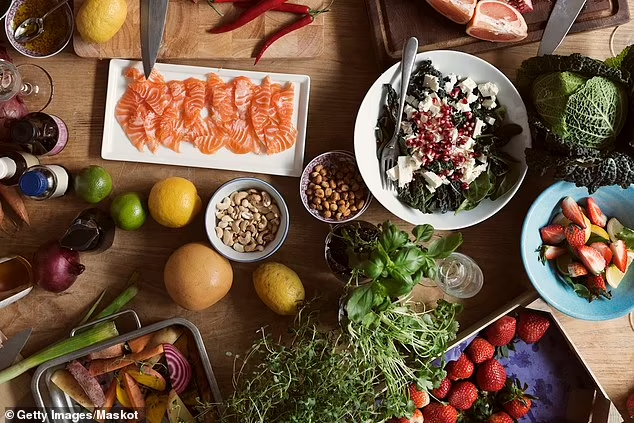Want to live a long and healthy life? Experts advise following this Nordic meal plan!
By
- Replies 8
When it comes to staying healthy, diet plays a big role. By following a healthy diet regimen, you can help keep your body in top condition.
There are many different ways to eat healthily, and it can be helpful to find a plan that works for you.
While there may be a number of diet plans out there that you can try, one regimen seems to be a standout among nutrition experts due to its well-balanced benefits.
Are you curious to find out what diet plan it is?
The Nordic diet is all about eating seasonal, local foods - and it could be the key to staying healthy and looking good all year long.
Fruit, vegetables, whole grains and fish are all on the menu, while milk products, meat and poultry are kept to a minimum. Saturated fats and processed meats are allowed in moderation, but the focus is on eating healthy, seasonal produce.
It should also be noted that the diet is comprised of heartier foods grown in colder climates, such as root vegetables like beets, carrots, and turnips, fruits like plums, apples, and berries, and fish like herring, according to Lola Biggs, dietitian at natural health supplement brand Together Health UK.
Aside from fresh produce, the diet also emphasises the importance of gut-friendly probiotic bacteria that consumers can get from eating fermented food like kefir.

The Nordic diet is all about eating seasonal, local foods - and it could be the key to staying healthy and looking good all year long. Credit: Getty Images/Maskot.
Lola said: 'The diet tends to limit the number of processed foods and saturated fats.'
'The Nordic diet uses canola oil from the rapeseed plant, an excellent source of heart-healthy unsaturated fats that also boosts good cholesterol.'
'As well as being well-balanced, it can be affordable as you are creating meals out of mostly whole grains, beans or lentils and plants that can be versatile and cheap.'
If you're looking to give this diet a go, here are some tips on how to follow the regimen:
1. Eat seasonally
When starting a Nordic diet, it is important to consider what is in season. Theoretically, seasonal food is planted, harvested, and sold during the height of its season.
Accordingly, fresh produce harvested during its season has fewer growth agents and tends to keep the majority of its health benefits. They are also at the height of supply, making them less expensive for farmers and less expensive for you.
Below are the lists of fruits and vegetables at their peak season:
2. Reduced consumption of processed foods
The main advantage of the Nordic diet, according to Tamara Willner, a nutritionist with the NHS-sponsored healthy eating programme Second Nature, is that it forbids the consumption of ultra-processed foods like cakes, crisps, chocolate, and carbonated beverages.
She explained: 'Any diet that excludes these foods, and focuses on building meals from whole foods will be a healthier option than the average western diet that we consume.'

The Nordic diet is also comparatively lenient compared to other diets. Credit: Shutterstock/RossHelen.
3. Higher intake of fermented foods
Fermentation is popular in Scandinavia. In fact, the first evidence of people practising fermentation was documented between 3000 and 6000 BC, on the east coast of Sweden.
Nutritionists are currently paying a lot of attention to fermented food because of its connection to gut health.
'Our gut hosts a huge number of gut microbes that feed off the foods we eat and produce more bacteria,' Tamara said.
'As a good general rule of thumb, the larger the variety of plant-based foods we're eating, the happier our gut (unless you suffer from IBS or are following a low FODMAP diet).'
There are many fermented food options available in Scandinavia — from fermented dairy such as Iceland's skyr and Sweden's yogurt-like filmjölk to pickled fish — people who subscribe to the Nordic diet will never be bored of it.
Other popular fermented foods that you may enjoy include sauerkraut, pickles, kefir, kombucha, miso, tempeh, kimchi, and yogurt.
What are the benefits of these foods to your health?
Numerous health benefits, such as a decreased incidence of cardiovascular illnesses, obesity, and type 2 diabetes, have been linked to eating a diet high in vegetables, fruits, whole grains, and lean protein with a limited intake of saturated fat, processed red meat, added sugar, and sodium, according to nutritionist Signe Svanfeldt.
She explained: 'By choosing unsaturated fat sources (such as nuts, seeds, fatty fish) instead of saturated fat sources (cream, butter and other animal fat) you also decrease the levels of LDL ('bad') cholesterol - and by that reduce the risk of cardiovascular diseases.’
'Proteins (found in fish and legumes) are important for many physiological functions, such as cell growth, immune system and enzymes.'
'By reducing the intake of processed red meat, as well as fatty animal protein sources, and, instead, choosing leaner protein sources (fish, poultry) or plant-based options (tofu, beans or lentils) you can reduce the risk of certain cancers.'
The nutrition expert also emphasised that the Nordic diet does not have any 'strict restrictions', explaining: 'The Nordic diet also features a large variety of foods which are key to a sustainable way of eating.'
'Having too many restrictions or forbidden foods in one's diet will only last for short periods of time and is not a sustainable lifestyle.'
We are definitely excited to try this diet and are looking forward to seeing the benefits it will give us (hopefully we end up having a healthy glow in our skin too!).
How about you? Will you be trying this new diet? Let us know your thoughts in the comments below!
There are many different ways to eat healthily, and it can be helpful to find a plan that works for you.
While there may be a number of diet plans out there that you can try, one regimen seems to be a standout among nutrition experts due to its well-balanced benefits.
Are you curious to find out what diet plan it is?
The Nordic diet is all about eating seasonal, local foods - and it could be the key to staying healthy and looking good all year long.
Fruit, vegetables, whole grains and fish are all on the menu, while milk products, meat and poultry are kept to a minimum. Saturated fats and processed meats are allowed in moderation, but the focus is on eating healthy, seasonal produce.
It should also be noted that the diet is comprised of heartier foods grown in colder climates, such as root vegetables like beets, carrots, and turnips, fruits like plums, apples, and berries, and fish like herring, according to Lola Biggs, dietitian at natural health supplement brand Together Health UK.
Aside from fresh produce, the diet also emphasises the importance of gut-friendly probiotic bacteria that consumers can get from eating fermented food like kefir.
The Nordic diet is all about eating seasonal, local foods - and it could be the key to staying healthy and looking good all year long. Credit: Getty Images/Maskot.
Lola said: 'The diet tends to limit the number of processed foods and saturated fats.'
'The Nordic diet uses canola oil from the rapeseed plant, an excellent source of heart-healthy unsaturated fats that also boosts good cholesterol.'
'As well as being well-balanced, it can be affordable as you are creating meals out of mostly whole grains, beans or lentils and plants that can be versatile and cheap.'
If you're looking to give this diet a go, here are some tips on how to follow the regimen:
1. Eat seasonally
When starting a Nordic diet, it is important to consider what is in season. Theoretically, seasonal food is planted, harvested, and sold during the height of its season.
Accordingly, fresh produce harvested during its season has fewer growth agents and tends to keep the majority of its health benefits. They are also at the height of supply, making them less expensive for farmers and less expensive for you.
Below are the lists of fruits and vegetables at their peak season:
SPRING | SUMMER | AUTUMN | WINTER |
| Berries Melons Cherries Peaches Broccoli Asparagus Fennel Artichokes | Apples Grapes Mangoes Watermelons Aubergine Corn Courgette Bell peppers | Cranberries Pomegranates Coconut Pears Butternut squash Cauliflower Mushrooms Swiss chard | Kiwi Pineapple Dates Grapefruit Brussels sprouts Cabbage Carrots Celery |
2. Reduced consumption of processed foods
The main advantage of the Nordic diet, according to Tamara Willner, a nutritionist with the NHS-sponsored healthy eating programme Second Nature, is that it forbids the consumption of ultra-processed foods like cakes, crisps, chocolate, and carbonated beverages.
She explained: 'Any diet that excludes these foods, and focuses on building meals from whole foods will be a healthier option than the average western diet that we consume.'
The Nordic diet is also comparatively lenient compared to other diets. Credit: Shutterstock/RossHelen.
3. Higher intake of fermented foods
Fermentation is popular in Scandinavia. In fact, the first evidence of people practising fermentation was documented between 3000 and 6000 BC, on the east coast of Sweden.
Nutritionists are currently paying a lot of attention to fermented food because of its connection to gut health.
'Our gut hosts a huge number of gut microbes that feed off the foods we eat and produce more bacteria,' Tamara said.
'As a good general rule of thumb, the larger the variety of plant-based foods we're eating, the happier our gut (unless you suffer from IBS or are following a low FODMAP diet).'
There are many fermented food options available in Scandinavia — from fermented dairy such as Iceland's skyr and Sweden's yogurt-like filmjölk to pickled fish — people who subscribe to the Nordic diet will never be bored of it.
Other popular fermented foods that you may enjoy include sauerkraut, pickles, kefir, kombucha, miso, tempeh, kimchi, and yogurt.
What are the benefits of these foods to your health?
Numerous health benefits, such as a decreased incidence of cardiovascular illnesses, obesity, and type 2 diabetes, have been linked to eating a diet high in vegetables, fruits, whole grains, and lean protein with a limited intake of saturated fat, processed red meat, added sugar, and sodium, according to nutritionist Signe Svanfeldt.
She explained: 'By choosing unsaturated fat sources (such as nuts, seeds, fatty fish) instead of saturated fat sources (cream, butter and other animal fat) you also decrease the levels of LDL ('bad') cholesterol - and by that reduce the risk of cardiovascular diseases.’
'Proteins (found in fish and legumes) are important for many physiological functions, such as cell growth, immune system and enzymes.'
'By reducing the intake of processed red meat, as well as fatty animal protein sources, and, instead, choosing leaner protein sources (fish, poultry) or plant-based options (tofu, beans or lentils) you can reduce the risk of certain cancers.'
The nutrition expert also emphasised that the Nordic diet does not have any 'strict restrictions', explaining: 'The Nordic diet also features a large variety of foods which are key to a sustainable way of eating.'
'Having too many restrictions or forbidden foods in one's diet will only last for short periods of time and is not a sustainable lifestyle.'
We are definitely excited to try this diet and are looking forward to seeing the benefits it will give us (hopefully we end up having a healthy glow in our skin too!).
How about you? Will you be trying this new diet? Let us know your thoughts in the comments below!







